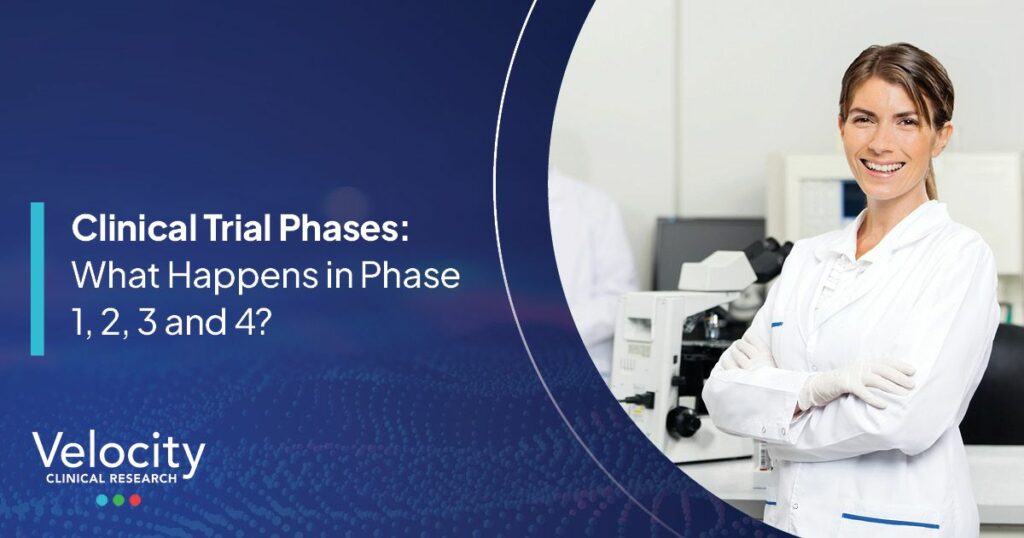Clinical trials are research studies of medications, vaccines, medical devices, procedures, diagnostics (tests), and other health-related products. These studies involve participants (also known as patients, volunteers, or subjects) to determine whether certain experimental products are safer and/or more effective than currently approved products. Without clinical trials, it would be impossible to develop new medicines, cures, vaccines, and other medical products — including everything from COVID-19 and flu vaccines, to infant formula, medications for diabetes, and pacemakers.
Clinical trials happen in four stages. Each stage, called a phase, serves a different purpose, and scientists collect important data at every step. Data must be reviewed and approved by the U.S. Food and Drug Administration (FDA) at each stage before a product can proceed to the next phase. In this article, you’ll learn about the clinical trial process in chronological order.
Preclinical Trials
Before a product can begin clinical trials, it first must be discovered, developed, and tested to determine if it is safe enough to test with humans. Typically, when a potential new product is discovered, researchers must determine the toxicity levels of the drug, the best method of use, dosages, how it interacts with other products, and more before employing it in preclinical trials.
Once a drug enters preclinical trials, it undergoes either in vitro (a closed environment like a test tube) or in vivo (in a living creature) testing. These studies, while small, provide detailed information on dosing and toxicity levels. After preclinical testing, researchers review their findings and decide whether the drug should be tested in people.
Phase 1 Trials
In Phase 1 clinical trials, products are tested with humans for the first time. Usually consisting of a small group of participants — about 20 to 80 total — the product is primarily evaluated for safety, with a secondary focus in identifying side effects and ideal dosage ranges. This phase usually takes a few months to a year to complete.
Oftentimes, participants of Phase 1 trials stay at a facility overnight for up to two weeks, depending on the product being studied. These trials generally pay clinical trial participants the most due to the elevated risk and study-related time involved.
Phase 2 Trials
If the product demonstrates safety in Phase 1, it can move into Phase 2 trials. In Phase 2 of a clinical trial, the product is given to hundreds of participants, nation- or world-wide, depending on the product. The second phase further studies safety, but primarily focuses on effectiveness. These studies typically last for months, and sometimes years.
The compensation for Phase 2 trials is often less than a Phase 1 trials since there is usually less time involved in participating. Phase 2 trials usually pay in the hundreds or up to a few thousand dollars.
Phase 3 Trials
If the product is seemingly effective, safe, and tolerable in the previous two phases, Phase 3 clinical trials can begin. These trials often involve thousands of patients and further assess safety, monitor side effects, and, if applicable, compare the product to other treatments currently on the market. This phase typically takes years to complete.
Phase 3 trials often pay less than Phase 1 and 2 studies, but depending on the product, can still pay hundreds or thousands of dollars to participants.
FDA Assessment
After successful Phase 3 trials, data gathered in clinical trials is sent to the FDA (and/or other governing bodies around the world) for review and approval. The FDA looks at all the data from the three phases of clinical trials to determine if an investigational product should be sold to consumers. Products being evaluated by the FDA may take months or years to be approved depending on how rare or potentially life-saving the product is.
In special circumstances — and only if the treatment appears to be both safe and effective in Phase 1 and 2 trials — the FDA can approve or authorize products before or during Phase 3 trials. Vaccines can acquire Emergency Use Authorization (EUA), and treatments, usually for certain cancers, can earn a similar status called accelerated approval.
In the case of the COVID-19 vaccines, EUA was granted by the FDA to get the vaccines from trials to market quicker due to their potential to slow the spread of the coronavirus and save lives. The Pfizer/BioNTech “Comirnaty” and Moderna “Spikevax” vaccines had undergone rigorous testing in both Phase 1 and 2 trials and were in Phase 3 trials when they received EUA, as they demonstrated both safety and effectiveness in the tens of thousands of trial participants collectively.
Phase 4
After a product receives FDA approval and is on the market for consumers to use, further clinical trials may continue to gather more information on side effects, risks, benefits, and best uses. These studies are known as post-marketing surveillance (PMS) trials.
Phase 4 trials usually include hundreds to a few thousand participants.
Drug Approval Success Rates
While we often hear about new drugs, vaccines, or medical products hitting the market after receiving FDA approval, there are many more that we never hear about. Most investigational products will never make it to market due to the rigorous standards the FDA demands for all new products. These regulations help ensure our health products are safe and effective. A Biotechnology Innovation Organization study looking at drugs in clinical trials during the years 2006-2015 found that only 9.6% of drugs entering Phase 1 clinical testing reached the market. Respectively, 30.7% and 58.1% of drugs failed to reach market after Phases 2 and 3.
Clinical Trials at Velocity
If you’re interested in learning more about or participating in a clinical trial with Velocity, visit our find a clinical trial page to speak with a recruitment specialist.
Further Reading
“The Drug Development Process,” Food and Drug Administration: https://www.fda.gov/patients/learn-about-drug-and-device-approvals/drug-development-process
“Phase II Trials in Drug Development and Adaptive Trial Design,” JACC. Basic to Translational Science: https://www.ncbi.nlm.nih.gov/pmc/articles/PMC6609997
“5 Things to Know About the FDA Approval Process,” MD Anderson Cancer Center: https://www.mdanderson.org/cancerwise/5-things-to-know-about-the-fda-approval-process-.h00-159463212.html
“Clinical Development Success Rates 2006-2015,” Biotechnology Innovation Organization: https://www.bio.org/sites/default/files/legacy/bioorg/docs/Clinical%20Development%20Success%20Rates%202006-2015%20-%20BIO,%20Biomedtracker,%20Amplion%202016.pdf
“Multidisciplinary Approach to Protocol Writing,” Applied Clinical Trials Online: https://www.appliedclinicaltrialsonline.com/view/multidisciplinary-approach-protocol-writing

